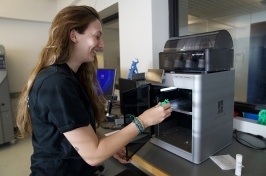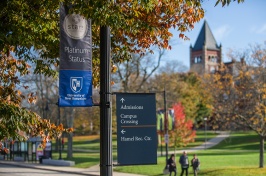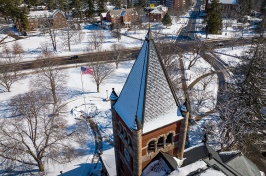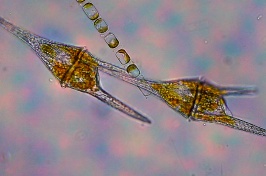The University of New Hampshire is a flagship research university that inspires innovation and transforms lives in our state, nation and world. More than 16,000 students from all 50 states and 71 countries engage with an award-winning faculty in top ranked programs in business, engineering, law, health and human services, liberal arts and the sciences across more than 200 programs of study. UNH’s research portfolio includes partnerships with NASA, NOAA, NSF and NIH, receiving more than $100 million in competitive external funding every year to further explore and define the frontiers of land, sea and space.
UNH Research Finds Maine Forest Management Hampering Ability of Forests to Reap Climate Benefits
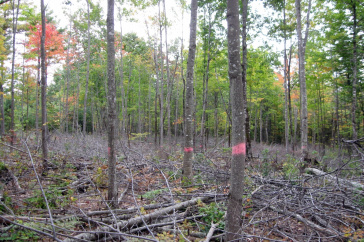
Harvest practices such as this thinning to release future crop trees from competition can lead to greater carbon storage in forests and forest products over the long term. Credit: John Gunn/UNH
DURHAM, N.H. – Over the last 20 years, Maine’s forests have become younger and less dense. As a result, forests are not providing the most climate benefits that they could through carbon sequestration and storage. However, more carbon could be stored over the next 100 years with less frequent harvests of smaller amounts of wood from each acre, according to new research from the New Hampshire Agricultural Experiment Station at the University of New Hampshire.
“Continuation of business-as-usual forestry will likely lead to Maine’s forest sector being a net carbon sink for the foreseeable future – meaning that when you add up all the carbon stored in the forest and also consider all the greenhouse gas emissions associated with harvesting trees and making forest products such as paper, lumber, and energy – there continues to be more carbon going into the system than going out,” said John Gunn, research assistant professor of forest management.
“But, we can do better. When we shift to forestry practices that less frequently harvest smaller amounts of wood from each acre, this leads to 14 to 33 percent more carbon stored over the next 100 years. This happens because trees would be allowed to grow older and larger and store more carbon than typically happens under current practices,” Gunn said.
In addition, there is an added climate benefit to less frequent harvests of smaller amounts of wood: when trees are eventually harvested, more of them will will be larger and can be used to make higher-value products such as lumber that also stores more carbon for a longer time when used to construct buildings. Harvesting more wood from each acre more frequently leads to a 30 to 70 percent reduction in carbon storage compared to current practices.
To conduct their analysis, Gunn and Thomas Buchholz with the Spatial Informatics Group used a life-cycle greenhouse gas accounting tool to test the sensitivity of Maine’s statewide forest sector greenhouse gas emissions to changes in forest management. Inputs included forest cover data and growth and yield models. They estimated net greenhouse gas emissions over 100- and 300-year time horizons of different management strategies across a range of carbon pools and emission sources. Carbon pools included storage in above- and below-ground live and dead biomass; storage in forest products in use and in landfills; harvest, transport, and manufacturing emissions; avoided emissions (substitution, bioenergy); and landfill methane fluxes.
“Climate change is happening and carbon dioxide is a major culprit,” said Gunn. “Forests and the products we make from them can help keep greenhouse gases like carbon dioxide out of the atmosphere. These findings show that we can manage forests in a way that provide more value to landowners and produce greater climate benefits.”
Going forward, Gunn and Mark Ducey, professor of forest biometrics and management, along with foresters from UNH Cooperative Extension, plan to identify the management decisions that New Hampshire foresters and landowners can make to restore forests that have been impacted by natural disturbances or past poor management practices. This work will be supported by a grant from the National Fish and Wildlife Foundation’s New England Forest and Rivers Fund.
This research is presented in a recent issue of the journal Forestry. It is based on work supported by the NH Agricultural Experiment Station, through joint funding of the National Institute of Food and Agriculture, U.S. Department of Agriculture, under award number 1010675, and the state of New Hampshire. This work also was supported by the Manomet Center for Conservation Sciences while Gunn was a senior program leader there.
Founded in 1887, the NH Agricultural Experiment Station at the UNH College of Life Sciences and Agriculture is UNH’s original research center and an elemental component of New Hampshire's land-grant university heritage and mission.
PHOTO AVAILABLE FOR DOWNLOAD
https://colsa.unh.edu/nhaes/sites/default/files/media/images/croptreerelease.jpg
Harvest practices such as this thinning to release future crop trees from competition can lead to greater carbon storage in forests and forest products over the long term. Credit: John Gunn/UNH
-
Media Contact
Lori Tyler Gula, PhD | NH Agricultural Experiment Station | lori.gula@unh.edu | 603-862-1452
Latest News
-
February 19, 2025
-
February 6, 2025
-
February 5, 2025
-
January 15, 2025
-
January 6, 2025















